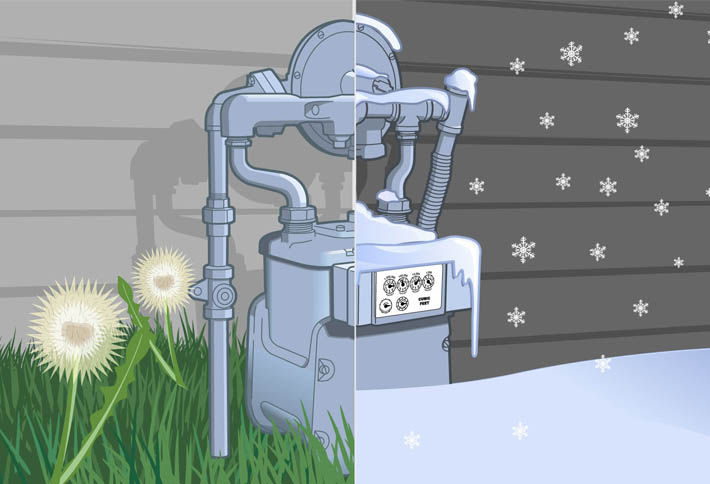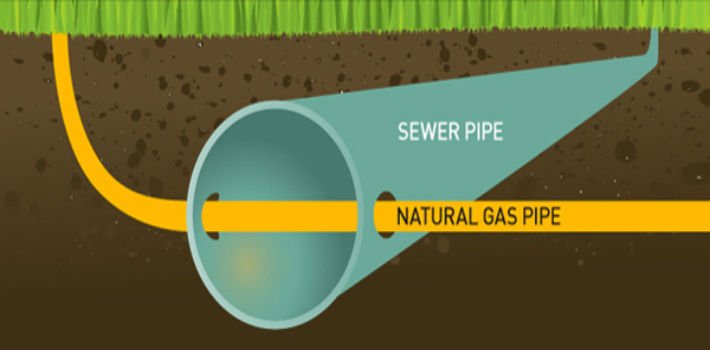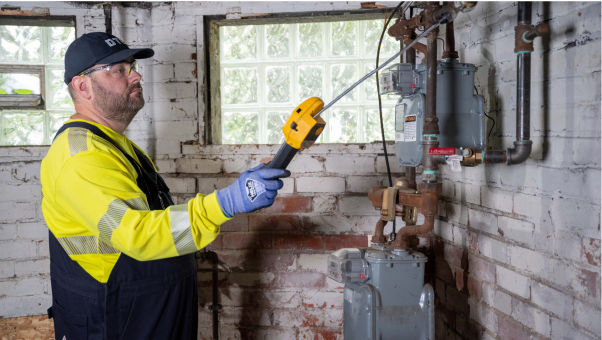Home Safety
Stay safe with natural gas.
We’re committed to ensuring ongoing safe and reliable delivery of natural gas to homes and businesses across our state. Find tips below on how to stay safe with natural gas and about gas meter inspections, and review how to detect a natural gas leak.

Indoor Natural Gas Safety Checklist
- Follow manufacturer's instructions on the operation and care of natural gas-fired appliances.
- Hire qualified contractors for installation and repair of natural gas appliances.
- Keep all combustible materials away from gas flames.
- Regularly clean burners and surrounding surfaces.
- Inspect the flues of appliances to ensure they are corrosion-free, securely attached and correctly vented.
- Unblock furnace room air vents. Appliances require proper air flow to burn fuel completely and operate efficiently.
- Teach children to never turn on or light gas appliances.
- Avoid brushing against or hanging items on natural gas pipes.
- Contact a licensed professionaI if the pilot flame of an appliance goes out. The professional should relight the appliance for your safety.

Outdoor Natural Gas Safety Checklist
Maintain a clear path to your gas meter all year long to accommodate service visits, periodic safety inspections and emergency situations. Practice meter safety in all seasons:
- Be careful around uprooted trees, especially after severe weather. Root systems can entangle buried pipelines, and a fallen tree may damage a pipe, resulting in a natural gas leak.
- Remove branches that may have fallen on the gas meter due to storms or high winds. Notify DTE about any visible damage.
- Trim tall grass, weeds and greenery around the gas meter.
- Do not allow leaves to pile up that will limit access to the meter during a service visit or emergency.
- Be careful using a shovel, snow blower or snowplow when clearing snow and ice near the gas meter. Remove snow and ice carefully by hand, brush or broom.
- Do not use sharp objects, salt, ice-melting chemicals or hot water to remove snow and ice from a meter.
- Cautiously remove ice hanging from roof edges above the meter.
- Clear your natural gas appliance vents and air intakes of obstructions to decrease the risk of carbon monoxide building up inside.
Meter Safety Inspections
If you’ve received a message from us saying it’s time for your indoor natural gas safety inspection, please call (877) 853-9434 today to schedule an inspection. It’s free, fast, and it’s required by the state of Michigan every three years. A technician, from our team or our approved vendor, RECONN, will need access inside your property for approximately 15 minutes to do a visual assessment and leak check of the natural gas meter.
Learn more about meter safety inspections:
Inside Safety Inspections FAQ
Inside Safety Inspections FAQ Additional Languages Version
Gas Leak | |
| If you smell or suspect a gas leak, leave the area immediately. Once you are in a safe place, call 911 and then call our Gas Leak Hotline at (800) 947-5000. | |
Fuga de Gas
Si huele o sospecha que hay una fuga de gas, abandone la zona inmediatamente. Una vez que se encuentre en un lugar seguro, llame al 911 y, a continuación, llame a nuestra línea directa para fugas de gas al (800) 947-5000.
تسرب الغاز
في حال شممت رائحة غاز أو شككت بوجود تسرب، غادر المكان على الفور. عندما تصل الى مكان آمن، اتصل على الفور بالرقم 911 وثم اتصل بخطنا الساخن المخصص لتسرب الغاز على الرقم 5000-947 (800).
Home Safety
Know carbon monoxide dangers and precautions you can take.
Carbon monoxide is a colorless, odorless and tasteless gas that is very hazardous. It can prevent you from breathing in the oxygen you need to survive.
Natural gas is safe and reliable form of energy. However, like any other material when burned, it can produce carbon monoxide. Learn more below about signs of carbon monoxide poisoning, potential sources and precautions you can take.

Carbon monoxide poisoning symptoms are similar flu symptoms:
- Breathlessness
- Dizziness
- Fatigue
- Headaches
- Nausea
Car
Dryer
Furnace
Gas Space Heater
Generator
Grill
Natural Gas Fireplace
Stove
Vents and Chimney
Water Heater
Carbon Monoxide Safety | |
If your carbon monoxide detector alerts you or if you suspect a carbon monoxide problem, act immediately to protect yourself and others.
| |
Seguridad frente al monóxido de carbono | |
Si su detector de monóxido de carbono envía una alerta o si sospecha que existe un problema relacionado con el monóxido de carbono, actúe inmediatamente para protegerse y proteger a los demás.
| |
السلامة من أول أكسيد الكربون | |
إذا قام جهاز كشف أول أكسيد الكربون الخاص بك بتنبيهك أو إذا كنت تشك في وجود مشكلة تتعلق بأول أكسيد الكربون، فاتخذ إجراءً فوريًا لحماية نفسك والآخرين. .غادر المبنى فورًا واخرج إلى الهواء النقي • .اتصل بالرقم 911، واطلب المساعدة الطبية إذا لزم الأمر • لا تدخل المبنى مرة أخرى حتى يتم تحديد أنه آمن من قبل اول المستجيبين او DTE. • | |
Carbon Monoxide Safety Precautions
What you should do:
| Install carbon monoxide detectors on a wall or ceiling near all sleeping areas in your home. For businesses, install carbon monoxide detectors in main areas away from vents and appliances or equipment that produce smoke or steam. | |
| Make sure natural gas appliances are properly installed, vented and maintained. | |
| Hire a maintenance professional to check your furnace and other fuel-burning appliances annually. | |
| Schedule an annual inspection of your flues, vents and chimneys to ensure they are clear of debris and in proper working condition. | |
| Keep the area around your heating equipment clean and unblocked to allow proper airflow. | |
| Shut and secure furnace compartment doors. |
What you should never do:
| DO NOT use a natural gas range or oven to heat your building. | |
| DO NOT run a generator inside your home, garage or other enclosed space. | |
| DO NOT operate a vehicle, lawn mower or grill in a closed garage. | |
| DO NOT sleep in a room with an unvented natural gas or kerosene space heater. | |
| DO NOT use a wood-burning fireplace and furnace simultaneously for long periods of time. This can cause back drafting. |
Home Safety
What is a cross bore and when is it dangerous?
A cross bore is an underground utility line that was inadvertently bored through a sewer, septic system or other underground line. It can pose danger if a sewer backup develops in your home or business.

Typically, homeowners and plumbers use mechanical rotary devices to clear blocked sewer or septic lines. The process will almost always damage a utility line that was bored through the sewer line and can cause gas to travel through the sewer line and into buildings. This could result in a major accident involving injuries, deaths and significant property damage. If an electric line is cut, there is risk of electrocution.
Follow these three steps to prevent safety risks.
Your safety is our top priority. That's why — despite never experiencing cross bore related incidents — we are communicating this important information to help prevent accidents.
Before using a mechanical rotary device to clean a blocked sewer line, anyone performing the work should
Use a camera to identify the location of the blockage. (A licensed plumber may provide this service.) | |
Call 811 or visit MISS DIG 811 to request emergency staking due to a sewer blockage. | |
Call DTE at (800) 477-4747 and request assistance with a suspected sewer cross bore. |
DTE is working to prevent cross bores.

DTE uses a trenchless, underground digging technique when installing new lines to bore through hard substances and minimize property damage. Boring through a sewer line feels no different to the equipment operator than boring through clay, and a cross bore created during this process may go undetected for months or even years.
DTE follows multiple best practices to reduce the risk of creating a cross bore, including contacting MISS DIG 811 to mark underground utilities before we dig and performing pre- or post-construction safety inspections of sewer lines with specialized cameras.
Gas Leak | |
| If you smell or suspect a gas leak, leave the area immediately. Once you are in a safe place, call 911 and then call our Gas Leak Hotline at (800) 947-5000. | |
Fuga de Gas
Si huele o sospecha que hay una fuga de gas, abandone la zona inmediatamente. Una vez que se encuentre en un lugar seguro, llame al 911 y, a continuación, llame a nuestra línea directa para fugas de gas al (800) 947-5000.
تسرب الغاز
في حال شممت رائحة غاز أو شككت بوجود تسرب، غادر المكان على الفور. عندما تصل الى مكان آمن، اتصل على الفور بالرقم 911 وثم اتصل بخطنا الساخن المخصص لتسرب الغاز على الرقم 5000-947 (800).
